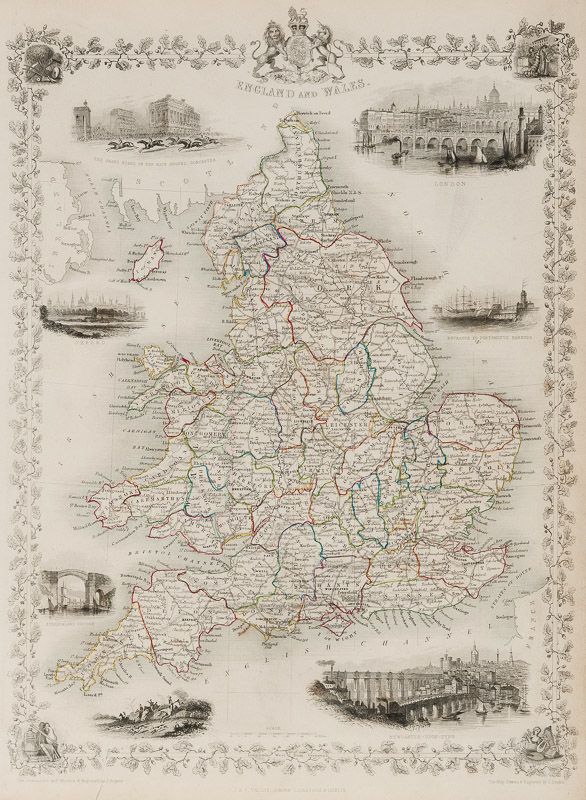Tallis, England and Wales - With Vignettes of The Grand Stand on the Race Ground
England and Wales – With Vignettes of The Grand Stand on the Race Ground, Doncaster, London, Entrance to Portsmouth Harbour, Newcastle-Upon-Tyne, Sunderland Bridge and Oxford.
Original steel engraving / Vintage map. Drawn and engraved by John Rapkin. Partly hand-coloured. Illustrations by N. Whitlock and Engraved by J. Rogers. London, Edinburgh & Dublin, J.& F. Tallis, 1851. Plate Size: 25 cm x 35 cm. Sheet Size: 27.2 cm x 37.3 cm. Vintage 19th century map in very good condition.
Published in the Illustrated Atlas, And Modern History Of The World Geographical, Political, Commercial & Statistical, Edited By R. Montgomery Martin.
Beautiful map of England and Wales from the mid-19th Century. Scotland can be seen to the north while the northern tip of Ireland is also included. France is shown peeping in in the lower right corner. The county structures are delineated across the map from Cornwall and Devon in the southwest to Northumberland in the northeast. The Welsh-English border is also delineated. The Isle of Man is included on the map. The railway system criss-crosses the map crowded with the names of cities and towns. Relief is shown with hachuring. Rivers are also shown.
John Tallis (7 November 1817 – 3 June 1876) was an English cartographic publisher. His company, John Tallis and Company, published views, maps and atlases in London from roughly 1838 to 1851.
Tallis set up as a publisher with Frederick Tallis in Cripplegate in 1842; the business moved to Smithfield in 1846, and was dissolved in 1849. From 1851 to 1854 Tallis operated as John Tallis and Company. He started The illustrated news of the world and national portrait gallery of eminent personages in 1858, selling it for £1,370 in 1861; it folded in 1863. (Wikipedia)
The most important project John Tallis undertook, was the ‘Illustrated Atlas’ from 1851. The original map we offer here, was part of this exceptional Atlas and all the maps it contained are still today considered as the last reminder of an era of lavish map production. Tallis worked the project together with John Rapkin (1815-1876) and it was Rapkin’s style and talent that we have to thank for when we marvel at these maps today. What makes these maps so special is the detail of engraved vignettes that surround the map and often show indigenous scenes, people in their environment and even more so, historical buildings or historical views of towns and cities, architecture and landscape.
The project of ‘The Illustrated Atlas’ was designed to be finished just in time for the anxiously awaited “Great Exhibition of the Works of Industry of All Nations” or The Great Exhibition, sometimes referred to as the Crystal Palace Exhibition in reference to the temporary structure in which it was held, was an international exhibition that took place in Hyde Park, London, from 1 May to 11 October 1851. It was the first in a series of World’s Fairs, exhibitions of culture and industry that became popular in the 19th century, and it was a much-anticipated event.
The Great Exhibition was organized by Henry Cole and Prince Albert, husband of the reigning monarch, Queen Victoria. It was attended by numerous notable figures of the time, including Charles Darwin, Samuel Colt, members of the Orléanist Royal Family and the writers Charlotte Brontë, Charles Dickens, Lewis Carroll, George Eliot and Alfred Tennyson. Music for the opening was under the direction of Sir George Thomas Smart and the continuous music from the exhibited organs for the Queen’s procession was “under the superintendence of William Sterndale Bennett”. (Wikipedia)
- Keywords: 19.Jahrhundert · 19th Century · 19th Century Map · Britain · British Maps · Cartography · Catalogue No.5 – Maps of the World · England · English History – Rare · Europe · John Tallis Maps · Map · Original Map · Original Maps · Original Steel Engraving · Rare Map – England · Rare Map – Wales · Travel England – Rare · Vintage Map · Vintage Old Map · Wales · Welsh History – Rare
- Language: English
- Inventory Number: 200118AG
EUR 375,--
© 2025 Inanna Rare Books Ltd. | Powered by HESCOM-Software
















